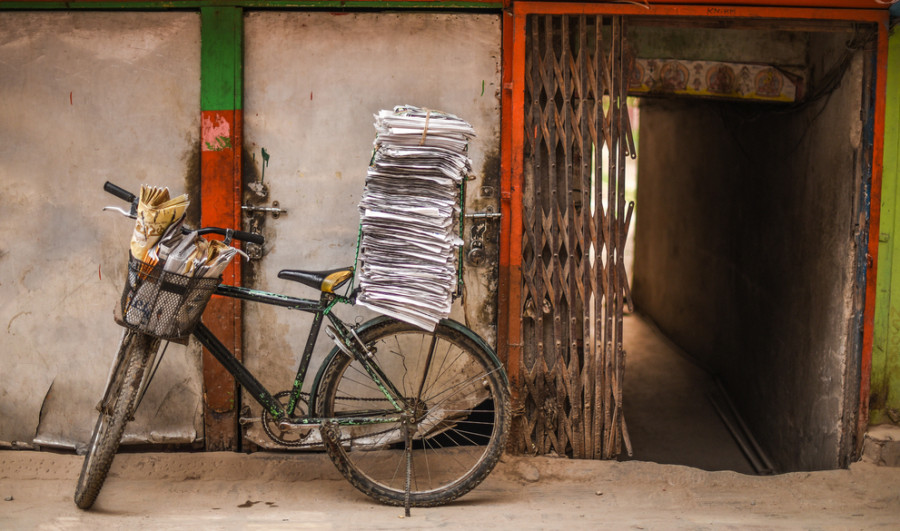Columns
Media freedom in Nepal
Despite the constitution guaranteeing legal provisions, there has been little progress in implementation.
Umesh Pokharel
The current status of press freedom in Nepal demonstrates a complex interplay between legal guarantees and practical challenges. Against this backdrop, this article reviews 2023-24 in light of several press freedom indicators, including the legal framework, media rights status, media independence, media pluralism, digital freedom, and media economy.
Legal framework
Despite the 2015 Constitution guaranteeing freedom of expression, right to information, and press and publication rights, limited advancements were observed in implementing these legal provisions in 2023-24. The Nepal government’s decision in mid-November of 2023 to ban Tiktok, a China-owned app alleging its content "being detrimental to social harmony" is a major example of this. The decisions follow the introduction of the “Directives on the Operation of Social Networking 2023”. Whatever arguments the government puts forward justifying the ban, this move is nothing but a blatant violation of the constitutionally enshrined rights.
Another example was the Home Ministry’s circular to the Chief District Officers (CDOs) in March 2024 directing them to monitor media and take action against online news portals, social media platforms and print media disseminating information posing a challenge to law and order. The directive was withdrawn following criticism from civil society. Similarly, in contrast to the constitutional provision (article 19) about safeguarding against pre-censorship, protecting communication equipment, and ensuring freedom from interruption under Article 19, the Civil Aviation Authority of Nepal (CAAN), in August 2023, sought clarification from Rameshwor Thapa, publisher of the Annapurna Media Network, over the news stories about poor airlines service in remote parts of Nepal published in the Annapurna Post daily. Thapa is the chairperson of Simrik Air as well.
Instances indicate that the government is biding its time for a conducive atmosphere to restrict press freedom. Despite objections to objectionable provisions, the National Cyber Security Policy of 2080 BS, endorsed in August 2023, overlooked recommendations from stakeholders. The government has put on hold bills like the Media Council Bill, the National Mass Communications Bill, and the Information Technology Bill due to objections from stakeholders, waiting for conditions to become more favourable to introduce them.
Media rights violation
According to the Federation of Nepali Journalists(FNJ), 68 cases of media rights violation took place from May 4, 2023 to May 1, 2024. FNJ’s media monitoring documents 4 cases of detention of journalists, four suits of obstruction on reporting, 16 cases of attack on journalists and media persons, 31 cases of misbehaviour, 12 cases of professional insecurity and one case of Gender Based Violence (GBV).
The arrest of Aishwarya Kunwar, a reporter for the privately owned news website Nigarani Khabar, and Puskar Bhatt, a correspondent for the private broadcaster of Mountain Television, by the police in Kanchanpur district of Sudurpaschim province in February 2024 following their reporting is a representative case of the media rights violations in 2023-24. Additionally, the notice issued by the Saptari CDO in July 2023, prohibiting the publication of photographs of the CDO office on social media and mainstream media, and the Supreme Court's order in April 2024 to take down one of the contents from www.sidhakura.com, are a notable example of such violations.
The current violation number is slightly higher than the violation (55) incidents in 2022-23. In 2022-23, a total of 55 violation cases were recorded by the FNJ. Similarly, in 2021-22, a total of 75 incidents of media rights violations were recorded. In 2020-21, the number of media rights violations were forty-five.
Fairness and independence
Ownership, advertisement, politics and other power were still the influencing factors on editorial stances, content priorities and presentation. A prominent example was Gorkhapatra daily's deliberate choice to place news of an incident, where two young individuals were killed by police during protests over the Employment Permit System (EPS) in Gwarko, Lalitpur on December 29, 2023, on the second page, significantly reducing its prominence and news value. The police took harsh action following the protestors torched the vehicle of Physical Infrastructure and Transport Minister Prakash Jwala. Funding sources and advertisement revenue also determined editorial stances and shaped news content in many instances. However, there is a distinction between newsrooms and business operations at least in mainstream newspapers in Kathmandu. The relationship however is blurred in the context of the cities out of Kathmandu.
Media pluralism
Nepal has over 1,000 newspapers, 1,100 local radios, 200 television channels and 4,100 registered online news portals, showcasing diversity in numbers, medium, and ownership. However, there is a noticeable rural-urban divide in infrastructure accessibility and use. Although most citizens can access various information channels, rural and marginalised communities face limitations. Women, people with disabilities, and traditionally marginalised groups still lack access to information. Furthermore, no consideration has been given to the access to information of the differently able person.
Digital freedom
Nepal has made significant progress in enhancing information accessibility by improving ICT and mobile connectivity. More than 91 percent of the population has internet access, primarily through mobile devices, highlighting its widespread penetration. However, only 37.8 percent of Nepali people access the internet via broadband services. Despite the increased internet penetration compared to the past, a study by the Center for Media Research(CMR) conducted in 2021 reveals that at least nine out of 10 individuals receive misinformation online regularly. Further, due to a lack of media literacy, people cannot differentiate the information between professional content producers and nonprofessional content producers, i.e., YouTube, Facebook, X and other social media platforms.
Media value undermined
There are some cases where the media played a crucial role in uncovering irregularities, and corruption, and scrutinising transparency and governance practices in 2023. An example of such an incident is the media’s coverage and continuous follow-up on bribery and corruption scandals involving high-profile politicians and bureaucrats the fake refugee scandal, and the Lalita Niwas scandal. In 2023, there were several instances of political leaders attacking journalists, and the press and undermining the value of journalism. A major case of this category is the remark by the Speaker of the House of Representatives (HoR), Devraj Ghimire in March 2023, who alleges that journalists are “for sale”. His statement remained controversial, prompting him to issue a correction afterward.
Economic downturn
Nepal’s media landscape which had already shrunk by Covid-19, struggled financially in 2023-24 primarily due to a significant downturn in advertising, shifting of the advertising to social media platforms including Facebook, and X. Consequently, numerous media outlets either closed down or adopted a 'downsizing' strategy, operating with minimal costs and limited human resources.
Next step
Efforts must be made to support and enforce existing legal frameworks. The advocacy efforts of the FNJ and other institutions should be continued to protest government attempts to curb press freedom. This will ensure protection for journalists and media entities. Additionally, initiatives aimed at promoting media literacy should be intensified. Last but not least, fostering an environment conducive to media pluralism and independence, including equitable access to information for all segments of society, must remain central to future policy and advocacy efforts.




 16.12°C Kathmandu
16.12°C Kathmandu















